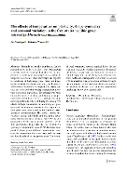The effects of temperature on plasticity, shape symmetry and seasonal variation in the freshwater benthic green microalga Micrasterias thomasiana

Publication date
2024Published in
Aquatic EcologyVolume / Issue
58 (3)ISBN / ISSN
ISSN: 1386-2588ISBN / ISSN
eISSN: 1573-5125Metadata
Show full item recordCollections
This publication has a published version with DOI 10.1007/s10452-024-10093-7
Abstract
Desmids are usually abundant in shallow peatland pools. In these localities, water temperature is closely linked to seasonal fluctuations in air temperature, so with increasing temperature extremes in temperate ecosystems, these microalgae are exposed to conditions of high-temperature stress. We investigated whether the shape, size, and growth rates of Micrasterias thomasiana, a frequently occurring species, are associated with varying temperatures in cultures and natural populations. The research was based on parallel analysis of clonal populations in temperature levels from 13 to 33 degrees C as well as cells from natural populations collected during the season. The effects of high temperature on morphological plasticity and fluctuating asymmetry in the shape of cellular parts were investigated by the landmark-based geometric morphometrics. The results showed that variation among individuals and fluctuating asymmetry between the lateral lobes of Micrasterias cells increased at 29 degrees C and in natural samples taken in July and October. In parallel, the size of semicells growing at temperatures above 25 degrees C decreased compared to those grown at lower temperatures. However, the temperature effects on shape and size were not directly related to the growth rates. The overall bilateral asymmetry between semicell halves did not change in relation to varying temperatures. In general, the results showed that morphological variation in natural populations of M. thomasiana reflected seasonal cycles and corresponded to plasticity associated with temperature changes in clonal cultures. It might therefore be possible to use these phenotypic markers as indicators of thermal stress in natural populations inhabiting shallow pools in peatlands.
Keywords
Desmidiales, geometric morphometrics, green algae, phenotypic plasticity, thermal stress
Permanent link
https://hdl.handle.net/20.500.14178/2885License
Full text of this result is licensed under: Creative Commons Uveďte původ 4.0 International






